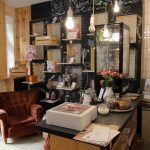From Bierfest to mass protest: a week in Munich
There’s more than one way to experience the rock-concert vibe in Munich. The past week demonstrates, whether for party or protest, how young and old come together in Bavaria’s capital in the spirit of Gemütlichkeit

Revellers dancing on the tables at Munich’s Frühlingsfest. Photograph: Christine Madden
“Ein Prosit der Gemütlichkeit!” Thousands of young people are standing on beer table benches – when they’re not jumping up and down on them – bellowing the traditional Bavarian beer-drinking song along with the band. They’re at the Frühlingsfest, a kind of mini Oktoberfest in April and May on the same festival grounds. Even though their final year leaving exams are taking place during these weeks, having a stonkingly great time.
The phrase could be translated as “A toast to relaxed, good times”. Gemütlichkeit is a very hard word to render in German, and Bavarians have basically claimed it for their own. It carries the sense of cosiness and relaxed, jolly conviviality. Gemütlich, however, is exactly what it isn’t in the beer tent. This is more like a rock concert, the tent jammed to the rafters, the crowd shouting along to the band playing oldies from the 80s and 90s. The people dancing on the tables are drunk on beer and enthusiasm. Most of them are dressed in Lederhosen and Dirndls.
I’m sitting in a section on the side with a workplace group that booked its table in advance. It’s clearly not the cool place to be. At the adjacent table, a woman in traditional dress, who’s realised this and doesn’t like it, stands up by herself on the bench her comrades are sitting on and jumps up and down. By the time I leave, she’s got her boyfriend to join her.
I can’t hear myself think, let alone hold a conversation with anyone whose ear is further than two centimetres from my mouth, but that’s hardly the point. The atmosphere is electric and infectious – as the woman jumping and swaying dangerously on her bench next to me would concur.
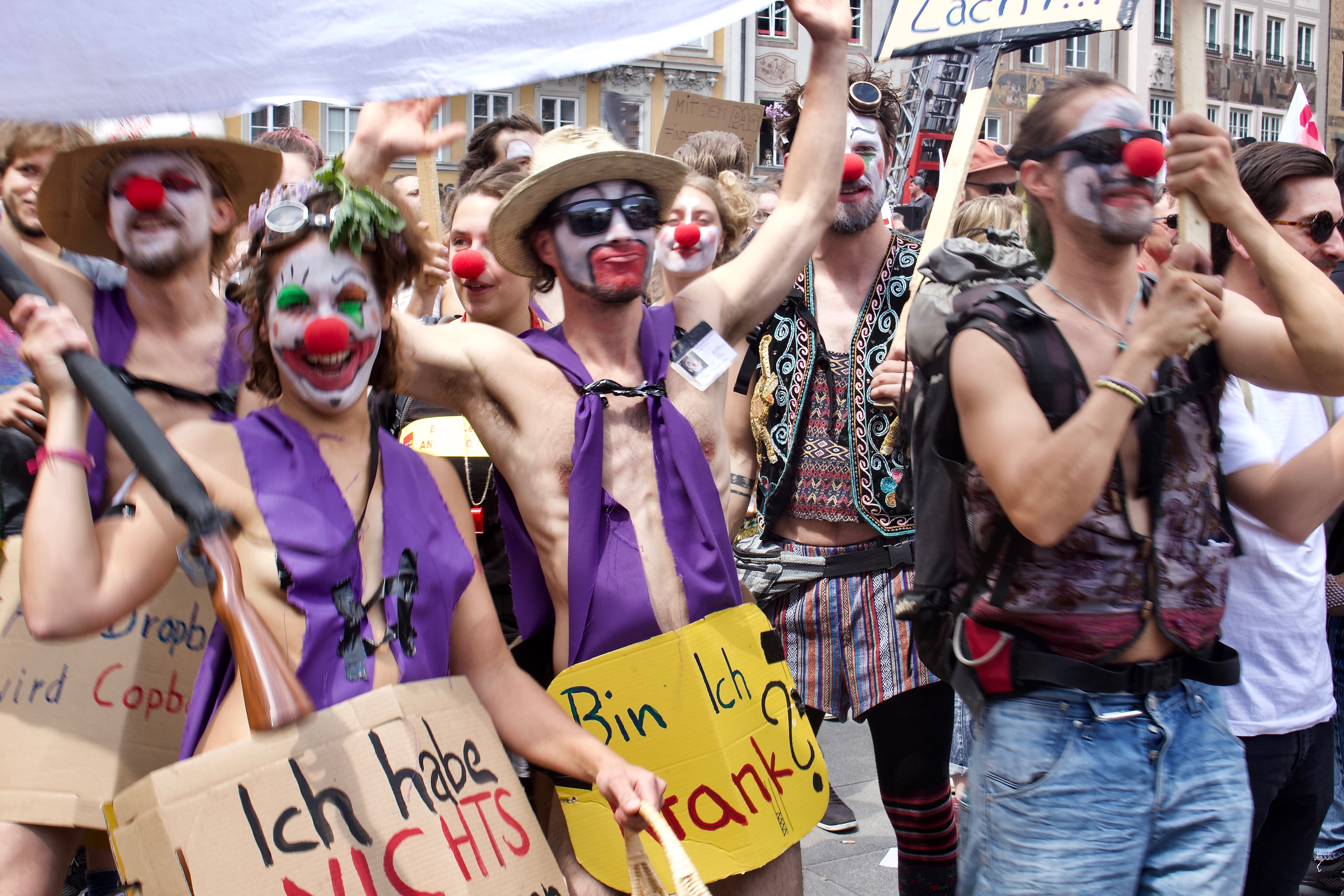
Revellers or rebels? Protesters with nothing to hide at the #noPAG demonstration in Munich. Photograph: Christine Madden
There’s a greater sense of Gemütlichkeit a week later at a very different gathering. On 10 May – Ascension Day, a bank holiday in Catholic Bavaria – a crowd assembles on the Marienplatz, the main town square in city centre Munich. They’re coming together for a demonstration to protest the new Polizeiaufgabengesetz (PAG), a policing regulations act that will give the Bavarian police force enlarged powers of surveillance, allow them to take action in “threatening danger” (as opposed to “explicit danger”) and theoretically make it possible to detain someone indefinitely without trial. The organisers of #noPAG are expecting 7,000 protesters. Up to 40,000 people turn up, carrying signs and banners, wearing T-shirts and stickers with anti-PAG slogans.
Like at a rock concert, the sense of belonging, of coming together for a common cause is strong, the camaraderie palpable. The Marienplatz is so full it’s impossible to manoeuvre through. The crowd swells into the side streets on all sides as far as the eye can see. When they start their planned one-kilometre march, there are so many more people than expected that the first people in the parade reach the end point at Odeonsplatz before the last stragglers on Marienplatz have even begun to move.
The governing party, the CSU, immediately criticised the demonstration and its organisers, the minister for the interior saying the protest was based Lügenpropaganda (mendacious propaganda, something that sounds a lot like “fake news”). The Bavarian minister president, despite sticking to his policy, strikes a more conciliatory tone, wanting to enter into dialogue with the PAG’s critics. The opposition, including the SPD, Green, Linke and other parties and organisations, continue adamantly to oppose the revised law. The government maintains the new law is necessary to ensure safety. The opposition asserts that it transgresses the federal constitution, encroaching on personal freedoms and privacy.
Bavaria will host state and local elections in October this year. The lines of opposition are sharpening. The one thing they all have in common: they believe in the Bavarian state and their ability to represent it. Their vision of how to uphold a peaceful, functioning and indeed gemütlichBavaria differ widely.
A sweet deal for pensioners
An innovative Munich start-up employs pensioners to bake old-fashioned, traditional cakes. It offers them the opportunity to earn money, feel useful and meet people – and their customers, to enjoy cakes baked with love

Oma Rosemarie (Rottmann), with Opa Günter (Haun), at work at Kuchentratsch. Photograph: Christine Madden
The sweet, warm fragrance envelopes you as soon as you walk through the door. Hidden in a courtyard from the busy street, the Kuchentratsch cake shop entices you in. Just beyond the counter, the doorway to the expansive kitchen stands open, affording a view to the bakers hard at work. Despite the size and industrial fittings of the bakery, you could imagine you’ve called in at your granny’s. The bakers here are all over 65.
Brought into being as a start-up by Katharina Mayer – who, in her 20s, is far from pension age – Kuchentratsch (translation: cake chat/gossip) is not simply a bakery. It’s also a social enterprise and thriving experiment. As an answer to the question “What kind of society would I like to live in when I’m old?”, the company was established to give pensioners the opportunity for suitable employment that also puts much-needed extra funds in their coffers.
“I started by asking myself, ‘Where can you get a really good piece of cake?’ But I always got the best cake at my own granny’s,” says Mayer.
Read more here
Published by The Local Germany, 9 March 2018
- Katharina Mayer, founder and head of Kuchentratsch
- View into the kitchen at Kuchentratsch. Photograph: Christine Madden
- Opa Günter (Haun), on a baking shift at Kuchentratsch. Photograph: Christine Madden
- Opa Günter hard at work in the Kuchentratsch kitchen. Photograph: Christine Madden
- Kuchentratsch shop and reception area. Photograph: Christine Madden
There’s no place like home
Unique, well-loved Munich café Kaffee Espresso & Barista is shutting down – another casualty of gentrification

Counter culture: baristas Heike Kahms and Boris Sliskovic at Kaffee Espresso & Barista. Photograph: Christine Madden
My “office” is changing hands, and I’m as gutted as the premises will be when they close it down. Strictly speaking, it’s not actually a workplace, but a local and much-loved café. I discovered this place almost seven years ago when I moved into the neighbourhood. It’s not showy or flashy, it doesn’t scream at you with shop-window marketing or streamlined, chichi interiors. Yet it emanates charm, intimacy and welcome. It has style without being stylish, beauty as opposed to fashion.
Munich is a property hotspot. Crushing difficulty in finding accommodation has become the norm. This situation has existed for decades, getting more difficult by the hour. But while German law protects private individuals regarding their rental contracts, no such protection is on the books for small businesses. This is what happened to the owner and proprietor of Kaffee Espresso & Barista, Thomas Leeb. Without any warning, he was unable to renew his lease, and he’ll have to move out of his establishment. After 15 years as a fixture of the local community of Neuhausen (centre-west Munich), the café will cease to exist.
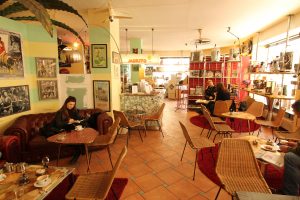
Interior of Kaffee Espresso & Barista. Photograph: Christine Madden
“I’ve lived here for 10 years, this is my local café,” says patron Christine Knesebeck, who visits almost daily with her dog Tonio. “It has a special atmosphere. There’s nothing like it. It should actually have protected status.”
Kaffee Espresso & Barista – which has the name Café Hausbrandt over its door – could be seen as a work of art; “people experience it that way,” says Leeb. “It’s a meeting place with many faces. We grant ourselves leave to express our individuality.” The café – which is, he says, a shop that serves coffee – is unique in several respects. The concept behind it combines a display and sales point for espresso machines, their accessories and the quality coffee to prepare in them. The same coffee is also prepared for customers who want to step into a mini, café-sized wormhole to a relaxed, 360-degree, full-sensory experience of another, more romantic time and space. Vintage posters from early 1900 onwards cover most of the wall space. Plush leather couches and rattan chairs surround polished stone and mosaic tables in intimate clusters. Lit shelves scattered throughout the café groan with different kinds of coffee, cups, coffee pots and espresso machines and a wide array of their accompanying paraphernalia. Leeb even lavishes attention on the choice of music, which ranges from French chansons and Latin rhythms to quirky Italian songs. Boxing this place up won’t just be a gargantuan task – it’s the vivisection of a social ecosystem.
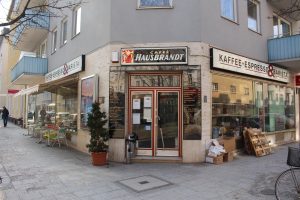
Street view of Kaffee Espresso & Barista. Photograph: Christine Madden
The district council is able to intervene to protect the atmosphere of its locality, but only concerning the sale of a building. In a case such as this, unfortunately, its hands are tied. Local government can do nothing to prevent the demise of Kaffee Espresso & Barista. “An appeal could be started,” says Anna Hanusch, the chair of Munich’s ninth district, where the café is located, “but ultimately the lessor has this right.” Although German law bestows certain protections on private tenants, small businesses and their owners have no such security. It would be necessary, acknowledges Hanusch, to change the law on a national level. As she also lives in the area, she says, “the café is a real institution, it’s a great shame” that it will close.
“Businesses have no protection whatsoever,” Leeb states. “That goes for rent increases and lease cancellation. Rents can be doubled. It’s called the free market.”
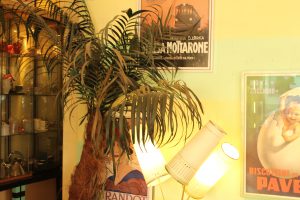
Corner wall, Kaffee Espresso & Barista. Photograph: Christine Madden
The lessor of the premises apparently has another patron lined up for the space – who will be putting a café in it, quelle surprise. But whether someone can also put an equivalent atmosphere in the space is doubtful. This is a neighbourhood café, and the locals who frequent it feel a strong sense of ownership – and great regret to see it vanish. Many people come here in the mornings for their coffee, sandwiches and pastries – takeaway or not – meeting and greeting one another as you would at your local pub. Patrons come and go throughout the day, in groups or alone, to work or hold meetings or to have a chat or just a moment’s respite with a coffee and a bun in an atmosphere described by barista Heike Kahms as “an Italian living room”. Shutting this down is gentrification without gentility.
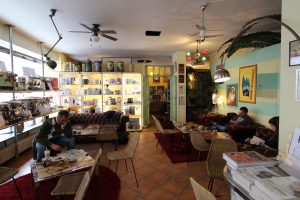
Interior of Kaffee Espresso & Barista. Photograph: Christine Madden
Leeb is actively searching for a new premises in the immediate area – which he acknowledges will be no easy task. In the meantime, Kaffee Espresso & Barista will close its doors to many desolate customers while he and his team box up the interior, which in its comfort and style emanates a certain, diva-like dignity.
“Building owners could decide to leave a café and not throw people out on the street,” laments Knesebeck. “I will miss this café very much.”
- Do you frequent this café and will miss it? Or do you mourn the loss of a beloved local fixture in your neighbourhood? We’d love to hear from you!
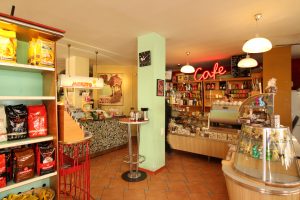
Bar area of Kaffee Espresso & Barista. Photograph: Christine Madden
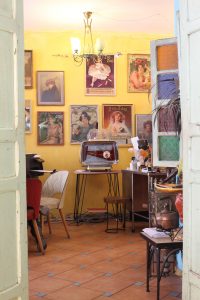
A peek into the back office at Kaffee Espresso & Barista
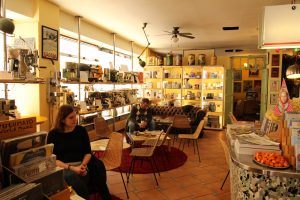
Interior of Kaffee Espresso & Barista. Photograph: Christine Madden
A woman of much importance
An extensive exhibition of 20th-century artist Gabriele Münter’s work shines a spotlight on a masterful painter deserving greater recognition
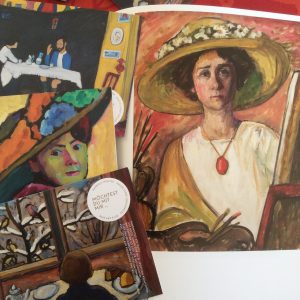
Gabriele Münter’s self-portrait (1908-1909) in the exhibition catalogue, along with postcards of (from top left) Kandinsky and Erma Bossi at the table (1912), Portrait of Marianne von Werefkin (1909) and The Birds’ Breakfast (1934). Photograph: Christine Madden
Her self-portrait in 1909 reveals much. Cover her face, and you see the beginnings of expressionism, already veering into abstraction. Then remove the covering, and the painting morphs into impressionism, dominated by the delicately painted detail of her face. The eyes timid and anxious, the lips pressed together nervously. The enormous hat, garlanded with daisies, looming over her head like a protective helmet. This woman is intensely aware of herself and feels a wistful longing, anxiety and insecurity in her picturesque surroundings. Even while she’s depicting herself with astonishing talent and an exceptional feel for colour.
Born in Berlin in 1877, Gabriele Münter was a prolific painter and graphic artist of the 20th century who, remembered chiefly as a member of the Expressionist Blaue Reiter movement in southern Germany and lover of Russian Expressionist Vasily Kandinsky, tragically faded into relative obscurity. A vibrant retrospective of her work in Munich’s Lenbachhaus – a modern art museum that has her to thank for its international renown – describes her development as an artist and displays her masterful, brilliantly colourful work.
Münter’s beginnings as an artist can be traced back to a trip she took with her sister after the death of her parents to visit relatives living in the US. Receiving the gift of a camera, she began to experiment with photography, taking atmospheric, painterly, often comical photographs of places in Missouri, Arkansas and Texas. They’re not so much snapshots as visual narratives. Her street scenes, landscapes and portraits – sometimes featuring the long, slim shadow of the photographer – reveal themes she would often repeat in her paintings.
She moved to Munich in 1901 and began to study painting in earnest. As a woman, she was unable to attend a state art academy, so she enrolled first at the art school of the Munich Women’s Art Society, then at the progressive Phalanx school – where Kandinsky was an instructor. They fell in love and had a secret affair, leading to their engagement, although Kandinsky was married. When the school shut down, they travelled throughout Europe and to Tunisia. Taken with the alpine landscape in southern Bavaria, Münter purchased a house in Murnau in 1909, which became the centre of the Blaue Reiter movement, spearheaded by Kandinsky, Franz Marc, Alexej von Jawlensky, Marianne von Werefkin, August Macke and herself.
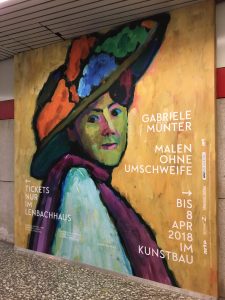
Gabriele Münter’s portrait of Marianne von Werefkin (1909) in the poster for her Lenbachhaus exhibition “Malen ohne Umschweife”. Photograph: Christine Madden
After the beginning of the First World War, Kandinsky returned to Russia; and Münter spent 1915-1920 in Scandinavia. Kandinsky visited her one last time in Stockholm in 1916, but then never answered her letters. He had divorced his wife in Russia in 1911, but then married another, younger woman in Moscow. He didn’t let Münter know; she had to find out about it from others. After an angry exchange of correspondence, she refused to hand over the many paintings that were still in “their” house in Murnau. When the Nazis gained ascendance in Germany and vilified “degenerate” art – weirdly dedicating an exhibition in Munich to the modern art they found decadent and depraved – Münter and her new partner, art historian Johannes Eichner, wrapped the paintings in newspaper and hid them in the cellar behind jam jars. Years later, for her 80th birthday, she made a present of them – more than 80 of Kandinsky’s paintings as well as hers and those of other exponents of the Blaue Reiter – to the civic gallery in the Lenbachhaus, turning it instantly from a small provincial collection into an internationally famous museum.
Despite her possession and preservation of these paintings, Münter spent the remaining years of her life still painting but in relative poverty. She tried to swap her paintings for bread, milk and meat, not with frequent success. (There must be dozens of residents of Murnau kicking themselves for not taking her up on the exchange.) She was shy and overshadowed by Kandinsky and the other male artists in her circle – and exhorted by her later partner Eichner to paint nice pictures people might like to hang in their living rooms – so she kept to herself. She died in 1962, leaving her estate to the Gabriele Münter and Johannes Eichner Foundation. Her relative obscurity in comparison with her Blaue Reiter colleagues is puzzling, especially as there had been extensive exhibitions of her work, for example in Copenhagen and Stockholm.
Throughout her life, Münter absorbed the spirit of the avant-garde artistic movements of the early 20th century, and her oeuvre shows a mastery of Impressionism, Expressionism, New Objectivity, and includes graphic arts techniques such as wood and linoleum printing. Her work features paintings of masks reminiscent of James Ensor’s, African influences like those of Picasso’s circle in Paris, and local folk and religious art. She – as well as some of the other artists in her circle – also studied the Central European traditional art form of reverse-glass painting (Hinterglasmalerei), which exerted a strong influence on their style.
Münter is celebrated for her exceptional and expressive use of brilliant, vivid colour in her landscapes, portraits and abstract work. And apart from that one telling self-portrait, she crops up frequently in other paintings – usually from behind, looking into the scene herself. She wants the viewer to look not at her, but with her at what she sees. And her vision of the world is astonishing.
Gabriele Münter: Malen ohne Umschweife continues at the Lenbachhaus until 8 April 2018
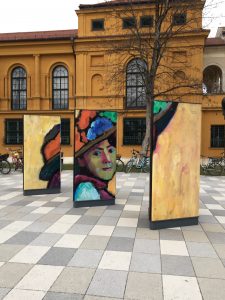
Display of Gabriele Münter’s portrait of Marianne von Werefkin (1909) in front of north wing of the Lenbachhaus. Photograph: Christine Madden
Brexit: ‘What can you live with?’
Award-winning journalist Fintan O’Toole speaks about the impossibility of Brexit and why nationalism is naive
 When the UK voted yes to Brexit, they forgot a minor detail. This minor detail – Ireland – will, as journalist and intellectual Fintan O’Toole explained, make negotiating any kind of Brexit at best an impossibility.
When the UK voted yes to Brexit, they forgot a minor detail. This minor detail – Ireland – will, as journalist and intellectual Fintan O’Toole explained, make negotiating any kind of Brexit at best an impossibility.
A long-time, award-winning columnist with the Irish Times, O’Toole presented a lecture at Munich’s Globe Business College on 19 January that approached the political phenomenon of Brexit from a historical and uniquely geographical viewpoint. Looking over from Ireland – a perilously close former colony of Great Britain, its closest neighbour across the Irish Sea – the prospect of Brexit appears absurd and dangerous to peace and stability – an own goal for a chimeric concept of Britishness.
The campaign for Brexit has been driven by a “visceral English nationalism”, O’Toole asserts. And it’s unusual, as the “English USP” is moderation and stability:
“They don’t do revolutions”. Their one revolution was “Glorious” because it was “bloodless”, and they didn’t have a socialist or fascist revolution in 20th century as so many of their European neighbours did. So this nationalism is poorly articulated, which made it much easier to grow without much attention.
One of the things a concept of nationalism needs is an oppressor, some kind of threat from outside, in order to engender fear, which in turn binds people together and strengthens its fabulous narrative. Because, as O’Toole states, “the basic problem of nationalism is that nations are ambiguous and fluid entities, a people held together by a common misconception of their origin”. A geographic unit of people that used to be the hub and chosen of an empire still retain an identity as an imperial power. Witness the “brilliant comedian and performance artist called Jacob Rees-Mogg” – a Eurosceptic conservative British member of parliament – who cites Agincourt, Crécy and Waterloo – all historical battlefields where the English won a resounding victory. But recalling old military successes from the Napoleonic wars of the 19th century – never mind the Hundred Years War of the 14th and 15th centuries – has embarrassingly little to do with the reality of the United Kingdom of the 21st century and its global position.
This “visceral” nationalism is naïve, claims O’Toole, especially as compared with the more tempered version across the Irish Sea. Irish nationalism is more “civilised” because “we’ve done the other bit” and have experienced the troubles – and the Troubles – it spawns. The importance of a realistic, inclusive vision of a nation is reflected in the Good Friday Agreement, achieved 20 years ago, in April 1998. The brilliance of the Good Friday Agreement,” explains O’Toole, “is not ‘what would you die for’ but ‘what could you live with?’”
Brexit has put everything that the Good Friday Agreement sought to allay back on the table. “What Northern Ireland really needed was 20 years of absolute boredom,” O’Toole says. Resting on EU law and regulation, the border between the Republic and Northern Ireland is an inner-EU border, which can be crossed without notice. And this intractable, insoluble issue has inserted itself into the centre of negotiations. There can’t be a hard border in Ireland. “The British establishment know it’s not doable, so they let [the issue] drift.”
Instead, during the first round of talks, the negotiators ended up scrambling to paste over once again this huge rift in the logic of Brexit. The term they finally came up with was “full regulatory alignment”. O’Toole appealed to any mathematicians in the audience. As far as he was aware, if A = B and B = C, then A must equal C. Applied to the circumstances surrounding Brexit, he surmised, “Ireland has regulatory alignment with Northern Ireland, and Northern Ireland has regulatory agreement with the UK. But Ireland also has regulatory agreement with the EU. So the UK also has to have regulatory alignment with the EU.” In other words, he says, it’s not going to work.
“This is what I think is going to happen,” O’Toole explains. Brexit will go into the second phase of trade talks and they’ll realise that no deal can be made in the designated time. Instead, the negotiators will agree a temporary treaty to carry them further into a longer limbo. The UK can achieve a kind of unattainable dream of Brexit but with full regulatory alignment. “This leaves us with a fundamental question: is it worth it?” O’Toole asks. “I think not. Somebody has to stand up and say, ‘You know, self harm is not a national policy”.”
Witches’ brew
A big pot of broth is a potion in more ways than one
 It’s that time of year when just looking outside, never mind stretching a tentative finger out from under the duvet, makes you feel shivery and chilled through. Even multiple cups of fresh, hot tea aren’t always enough to tempt you to shed your blanket. The winner every time, though, is the promise of a rich and aromatic cupful of steaming broth.
It’s that time of year when just looking outside, never mind stretching a tentative finger out from under the duvet, makes you feel shivery and chilled through. Even multiple cups of fresh, hot tea aren’t always enough to tempt you to shed your blanket. The winner every time, though, is the promise of a rich and aromatic cupful of steaming broth.
I used to absolutely hate making broth. It was always an insipid disaster. Every so often I’d try making broth again, and every time it would be the same watery slop more reminiscent of rinsing water than anything else. I’d have to heave spoonfuls of powdered stock mix into just to be able to drink it.
Then, suddenly, magically, it worked. After having tried and tried again, having a go at various tips and recipes, a large potful of various ingredients suddenly turned into something incredible – rich, flavoursome and so warm and comforting. It was like magic.
What made the difference this time was treating it almost as something alchemical. I think of the people in history, wise men and women, who understood about plants and animals, fungi and minerals, who learned how to combine these things into nourishing, healing and restorative broth – potions – and how this knowledge made them respected and frequently feared.
It’s the alchemy of cooking that keeps me interested in it (as well as the daily need for something tasty to eat). Every time I make a yeast dough, I actually get a thrill observing how the ingredients physically transform during kneading from a big, swampy slosh into the elastic and resilient ball. It’s perennially exciting to watch a variety of ingredients interacting with heat, physical intervention and each other to metamorphose into something you’d not only instagram but also put in your mouth and consume with pleasure.
Treating the individual ingredients and every step reverentially – from meat and bones to onions, carrots and herbs – seems to draw out and combine the individual energy of the ingredients into something extraordinary. I think of how people were pursued for this knowledge as I watch the various colourful ingredients of the broth bubble away in the water and am grateful to live in a time of ample provision, and a time in which scientific curiosity in the world is not persecuted and punished. Of course you can get all kinds of broth in all kinds of supermarkets, any time of the day or night. It’s frequently a lifesaver to have that convenience in days filled with work and stress. But there’s something especially warming and nourishing about making your own. You won’t be changing lead into gold, but then again, in a way, maybe you will.





